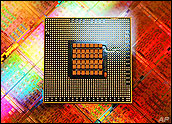
Plunging prices in a glutted memory-chip market served as a weight on semiconductor sales worldwide, although sales did increase by 1.5 percent in February, according to the Semiconductor Industry Association.
Fueled by sales of computers and mobile phones outside the U.S., global year-on-year semiconductor sales increased to US$20.44 billion in February from $20.14 billion at the same point in 2007, according to the San Jose, Calif.-based group.However, sales were down 4.9 percent from $21.48 billion in sales in January.
“February is not normally a strong month, so the sequential decline is in line with historical patterns,” SIA spokesperson John Greenagel told the E-Commerce Times.
DRAM Price Slide Not Uncommon
Falling prices in the dynamic random access memory (DRAM) chip market — the most common type of memory chip in personal computers — are not an unheard-of phenomenon, but the drop is even more stark today, he noted.
“The biggest weakness is in DRAM pricing,” Greenagel said. “The units are way up, but the prices are down about 60 percent, year on year.” That compares to a typical decrease of about 30 percent in other years.
There’s a glut of DRAM on the market because manufacturers, rather than giving up market share, will simply cut prices, he noted. “It’s a great bargain for everybody buying a computer. They can get more memory for less money.”
However, the SIA data doesn’t reflect the most current DRAM supply trends, Hans Mosesmann, an analyst with Raymond James, told the E-Commerce Times.
“There’s evidence that there’s a supply balance,” he said. “I think DRAM pricing is materially down, but you look at data points on a monthly basis, and it shows contract pricing grew January to February, and March probably ended up being five percent or so.”
Chip Shortage Coming?
It’s not out of the realm of possibility to see possible short supplies of memory chips as the year unfolds, Mosesmann added. “DRAM pricing dynamic is a little out of sync with end-market pricing. For pricing to be stable and up over the last couple of months [suggests] that supply is down — not a glut. There was a glut at the end of last year, but the supply entering the market is decelerating.”
Markets outside the U.S. showed strong growth in demand for electronic products that drive semiconductor sales, the SIA said.
“The Asia-Pacific region, which includes China, has overtaken the U.S. as the largest market for PCs,” SIA President George Scalise noted, adding that the other markets outside the U.S., as a unit, equaled the U.S. in PC sales last year and likely will overtake the U.S. market in 2008.
Sales of handsets have shown even more dramatic growth, he added, quoting JPMorgan figures showing that shipments of handsets to the Asia-Pacific region will reach nearly 540 million units in 2008 — more than three times the 161.6 million sales expected for the U.S. this year.
Data Based on Moving Averages
The SIA’s statistics are problematic because the group’s sales figures are based on moving averages, said UK-based Gartner analyst Richard Gordon.
“I don’t like this way of reporting,” he told the E-Commerce Times, adding that he prefers to base sales figures on raw data.
The raw sales data for January and February, Gordon noted, show that January 2008 was down 18 percent from December, which he said was a normal seasonal trend, and down 1 percent compared with January 2007. The data also show February 2008 was down 2 percent from a month earlier but up 4 percent over February 2007.
“There’s nothing much to say about the first two months’ sales, except that the industry is not in meltdown, despite the dire warnings on the economy,” he continued. “It looks like 2008 first quarter sales will come in at about $62 billion, compared with $61 billion in 2007, but this will be a sequential quarterly decline of about 7 percent, compared with the fourth quarter of 2007, which is toward the bottom of the range.”
The industry likely will post annual growth “in the low single digits” in 2008, compared with 2007, Gordon noted.























































Social Media
See all Social Media